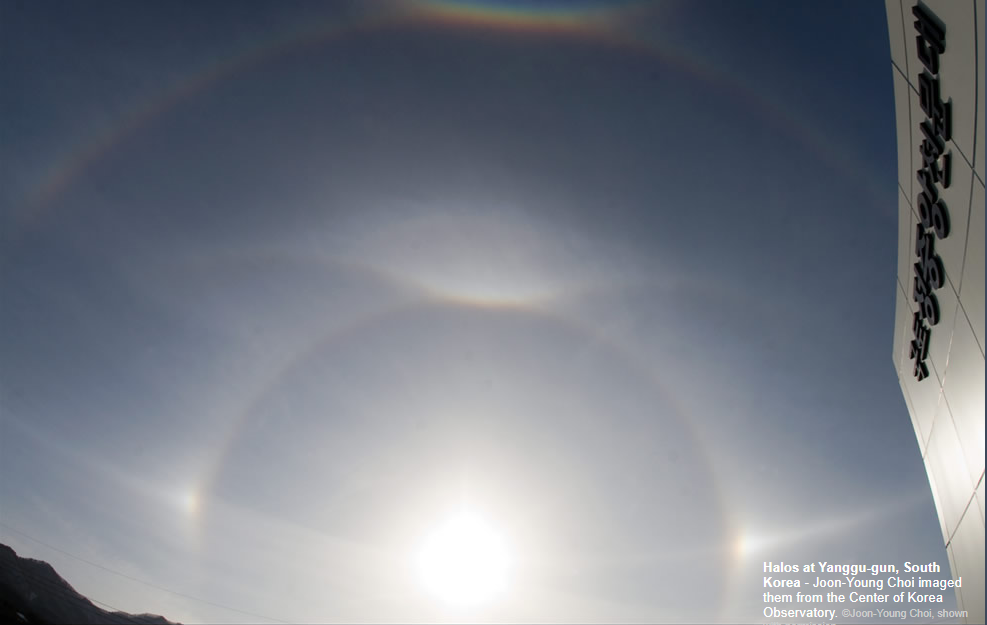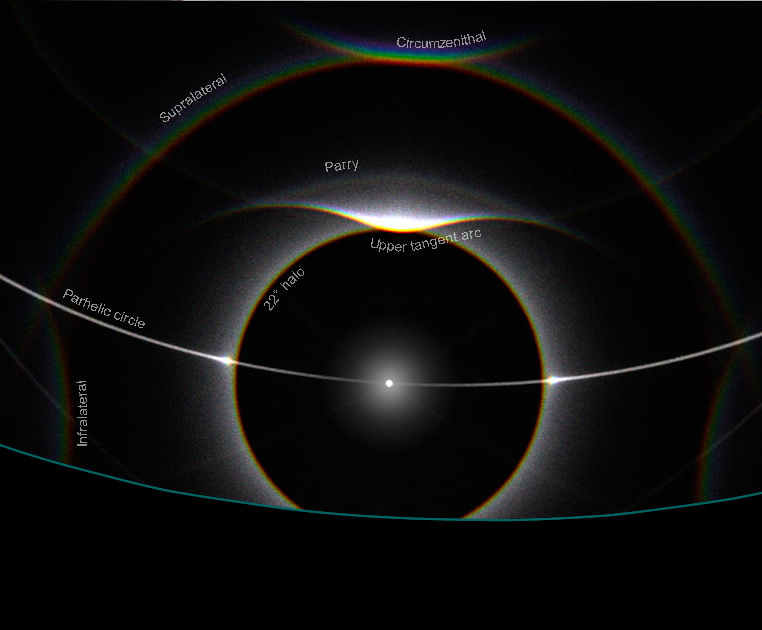Korea Halos
Korea Halos: A Mesmerizing Display of Atmospheric Optics
When it comes to atmospheric optics, few phenomena captivate the imagination as much as halos. These enchanting optical displays can be witnessed in various parts of the world, and South Korea is no exception. In the region of Yanggu-gun, a captivating showcase of halos was captured by Joon-Young Choi from the Center of Korea Observatory. Let's delve into the intricate details of this remarkable atmospheric phenomenon and explore the various components that contribute to the mesmerizing Korea Halos.
Unraveling the Components of Korea Halos
The Korea Halos display in Yanggu-gun showcases an impressive array of halo formations. While the 22° halo is clearly visible, there is also a possibility of a weak 46° halo, although it is uncertain due to the presence of a strong overlapping supralateral arc. The formation of these halos can be attributed to the presence of ice crystals in the atmosphere, each contributing to the unique patterns observed.
The Role of Ice Crystal Alignments
Ice crystals play a crucial role in the formation of halos. In the case of Korea Halos, four out of the five ice crystal alignments contribute to the display. Randomly oriented or poorly aligned crystals contribute to the formation of the 22° halo, while column-shaped crystals create the upper tangent arc that tops the halo. Furthermore, the presence of Parry oriented crystals generates a weak suncave Parry arc. Although Parry crystals are typically rare, their efficient generation contributes to the visibility of Parry arcs in this particular display.
Exploring Crystal Orientations
In addition to Parry crystals, Lowitz oriented crystals also make an appearance in the Korea Halos display. However, unlike Parry crystals, Lowitz oriented crystals produce arcs less efficiently, resulting in their rarity. On the other hand, plate-shaped crystals prove to be efficient halo makers. These crystals contribute to the formation of sundogs, as well as the majority of the circumzenithal arc (CZA). It is worth noting that Parry crystals also play a role in the creation of CZAs.
Traversing the Sun: The Parhelic Circle
One of the most captivating aspects of the Korea Halos display is the parhelic circle, which traverses the sun. This phenomenon occurs due to the combined contribution of all crystal orientations. The parhelic circle adds to the overall splendor of the atmospheric optics showcased in Yanggu-gun.
The Complexity of Atmospheric Optics
The intricate interplay of various crystal orientations and alignments gives rise to the mesmerizing Korea Halos. These displays serve as a reminder of the complexity and beauty of atmospheric optics. While we can unravel some of the mechanisms behind these phenomena, there is still much to learn and explore.
Conclusion
The Korea Halos display in Yanggu-gun, South Korea, offers a captivating glimpse into the world of atmospheric optics. The presence of different ice crystal alignments and orientations contributes to the formation of halos, arcs, and other optical phenomena. Witnessing such displays reminds us of the awe-inspiring beauty that can be found in the natural world. As we continue to study and understand atmospheric optics, let us embrace the enchantment and intrigue they bring to our lives.

Halos at Yanggu-gun, South Korea - Joon-Young Choi imaged them from the Center of Korea Observatory. ©Joon-Young Choi, shown with permission.

A classic display with 4 of the 5 ice crystal alignments contributing.
Random or poorly oriented crystals made the 22° halo and possibly a weak 46° halo.
The latter is uncertain because there is a strong overlapping supralateral arc from singly oriented column crystals. Columns also made the upper tangent arc topping the 22° halo.
Above that is a weak suncave Parry arc produced by the very improbably Parry oriented crystals. We only see Parry arcs because their generation is very efficient indeed. Otherwise the usual low concentration of Parry oriented crystals would only produce halos exceptionally rarely. The HaloSim ray tracing used a mere 1% Parry crystals.
Lowitz oriented crystals could be a less improbable but their arcs, unlike those of Parry, are produced very inefficiently with the result that we almost never see them.
Plate crystals are efficient halo makers and here they yielded the sundogs and most of the circumzenithal arc (Parry crystals also make CZAs).
All the crystal orientations contributed to the parhelic circle traversing the sun.
Note: this article has been automatically converted from the old site and may not appear as intended. You can find the original article here.
Reference Atmospheric Optics
If you use any of the definitions, information, or data presented on Atmospheric Optics, please copy the link or reference below to properly credit us as the reference source. Thank you!
-
<a href="https://atoptics.co.uk/blog/korea-halos/">Korea Halos</a>
-
"Korea Halos". Atmospheric Optics. Accessed on April 20, 2024. https://atoptics.co.uk/blog/korea-halos/.
-
"Korea Halos". Atmospheric Optics, https://atoptics.co.uk/blog/korea-halos/. Accessed 20 April, 2024
-
Korea Halos. Atmospheric Optics. Retrieved from https://atoptics.co.uk/blog/korea-halos/.